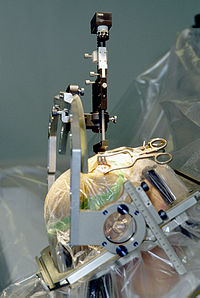
Photo from wikipedia
BackgroundThyrotropin-producing adenomas (TSHomas) account for approximately 1–2% of all pituitary tumors. Recently, there has been debate on primary treatment as some studies suggest a high rate of hypopituitarism after transsphenoidal… Click to show full abstract
BackgroundThyrotropin-producing adenomas (TSHomas) account for approximately 1–2% of all pituitary tumors. Recently, there has been debate on primary treatment as some studies suggest a high rate of hypopituitarism after transsphenoidal surgery and therefore suggest primary use of somatostatin analogs (SSA) instead. We would like to challenge this assumption by presenting our single-center experience with transsphenoidal surgery for TSHoma.MethodsFifteen patients treated consecutively between May 2010 and December 2016 were analyzed for long-term postoperative remission and pituitary function.ResultsData on the development of TSH, fT3 and fT4 were available for 12 of 15 patients (mean follow-up was 18 months, 8 patients >12 months), showing mean TSH levels of 1.289 mU/l (0.02–2.04, SD 0.66), mean fT3 levels of 3.76 pmol/l (0.5–6.16, SD 1.8) and mean fT4 levels of 16.5 pmol/l (11.7–21.9, SD 3.66). Six of those patients were substituted with a mean of 85.4 μg L-thyroxine after a median follow-up of 20.7 months. The other six patients did not receive L-thyroxine at a median follow-up of 15.5 months. One patient with a known tumor remnant on MRI stayed euthyreotic with cabergoline at the timepoint of follow-up 22 months after the operation.Control of the corticotrop axis was also available in 12 of 15 with no patient showing a corticotroph insufficiency in the long term.ConclusionsWe argue that transsphenoidal surgery for TSHoma should be considered as the treatment of choice as remission following surgery is highly probable and postoperative hypopituitarism is very unlikely if patients are referred to centers with high pituitary surgery case loads.
Journal Title: Acta Neurochirurgica
Year Published: 2017
Link to full text (if available)
Share on Social Media: Sign Up to like & get
recommendations!